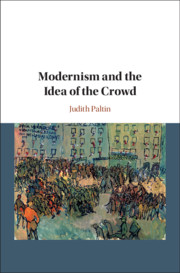
-
Select format
-
- Publisher:
- Cambridge University Press
- Publication date:
- November 2020
- December 2020
- ISBN:
- 9781108907026
- 9781108842235
- Dimensions:
- (229 x 152 mm)
- Weight & Pages:
- 0.5kg, 236 Pages
- Dimensions:
- Weight & Pages:
- Subjects:
- Literature, Literary Theory, English Literature 1900-1945
You may already have access via personal or institutional login- Subjects:
- Literature, Literary Theory, English Literature 1900-1945
Book description
This book argues that modernists such as James Joyce and Virginia Woolf engaged creatively with modernity's expanding forms of collective experience and performative identities. Judith Paltin compares patterns of crowds in modernist Anglophone literature to historical arrangements and theories of democratic assembly to argue that an abstract construction of the crowd engages with the transformation of popular subjectivity from a nineteenth-century liberal citizenry to the contemporary sense of a range of political multitudes struggling with intersectional conditions of oppression and precarity. Modernist works, many of which were composed during the ascendancy of fascism and other populist politics claiming to be based on the action of the crowd, frequently stage the crowd as a primal scene for violence; at the same time, they posit a counterforce in more agile collective gatherings which clarify the changing relations in literary modernity between subjects and power.
Reviews
‘… dense but perfectly argued … Paltin's important, innovative study is published at an opportune moment.’
Gerri Kimber Source: The Times Literary Supplement
‘The text itself is definitely easier to approach in Field’s version as the tales are not obscured by countless footnotes and different kinds of brackets. With the amount of reconstructive work done by Field, it is visible that this kind of layout is a logical choice. It seems that the reader’s comfort as well as usability and functionality have been thought out … an interesting addition to Arthurian literature studies and can be used both by students and academic scholars for different purposes.’
Malwina Wiśniewska-Przymusińska Source: Studia Anglica Posnaniensia
Contents
Metrics
Altmetric attention score
Full text views
Full text views help Loading metrics...
Loading metrics...
* Views captured on Cambridge Core between #date#. This data will be updated every 24 hours.
Usage data cannot currently be displayed.
Accessibility standard: Unknown
Why this information is here
This section outlines the accessibility features of this content - including support for screen readers, full keyboard navigation and high-contrast display options. This may not be relevant for you.
Accessibility Information
Accessibility compliance for the PDF of this book is currently unknown and may be updated in the future.


